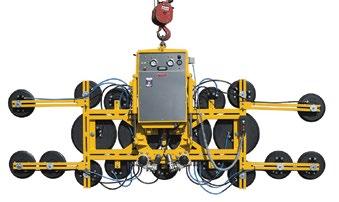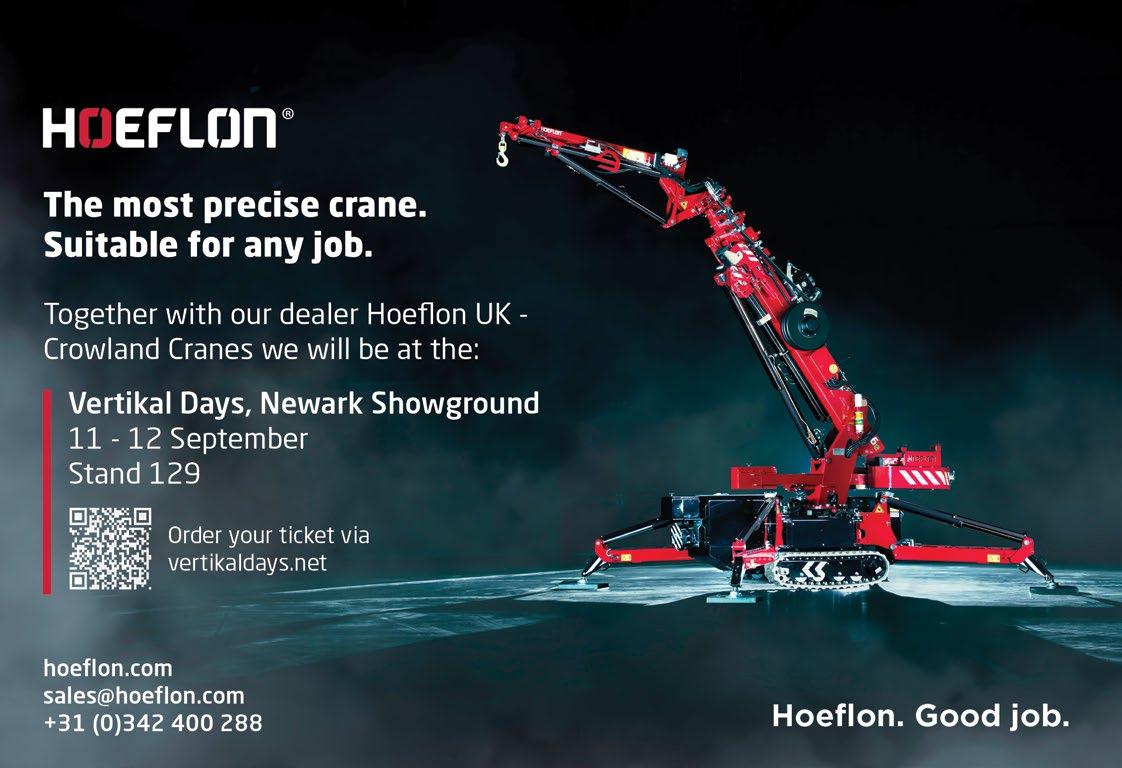
13 minute read
Skilled glass panel manipulation
Skilled glass panel manipulation
Over the past few years a number of factors have led to the dramatic growth in the use of structural glazing at the same time as triple glazing and other forms of improved insulation have become popular and necessary. Stricter manual handling regulations, have also come into force obliging glazing companies to adopt new methods of working. The lifting industry has responded with new equipment and innovative solutions. We take a look at a few examples.
Glass and window installation is now a highly skilled trade that also requires the ability to use the wide variety of handling equipment available. The days of two or more people lifting and pushing a heavy window into place are now largely behind us, while the growing variety of equipment and methods enable windows and glazing panels to be installed more quickly and safely than ever before, and increasingly to greater heights.
Equipment such as the spider crane equipped with vacuum attachments became the standard ‘go-to’ product for many glazing jobs a good few years ago, particularly when fitted with searcher hooks and cantilever beams. Their ability to cope with rough and uneven sites, taking up little space, and to level on inclines can be the difference between a quick, easy job and an impossible task. On high rise construction they can be equipped with long hoist ropes to lift or lower panels into place from floors above installing panels several floors below the crane, while a growing armoury of attachments allow the user to reach under or over obstacles.
But in a similar ‘chicken and egg’ scenario to ever larger cranes, which came first - the larger glass handing machine or the bigger heavier glass panels? Whichever it was, there is now an increasing amount of ‘off the shelf’ equipment capable of lifting a wide range glass panels in terms of size, weight and reach.
However, these highly sophisticated machines are often too complex and expensive to be a sensible option for the majority of simple installation jobs. An issue some companies are working to overcome.
An increasing number of telehandlers and aerial work platform manufacturers now offer specific glass installation attachments, either with a new machine or for use with existing models.

Telehandler attachment
Italian telehandler manufacturer Magni has unveiled a new attachment for lifting and installing large individual flat panels in high and awkward to reach locations, making it far easier to position them at heights well beyond the reach of glazing robots and spider cranes.
Designed for use with Magni 360 degree models, the Vacuum ER-Litocran 700 consists of a power pack, a short two section telescopic jib mounted on a slew ring with 180 degrees of rotation and 90 degrees of articulation above and below the horizontal, all topped by a four suction cup vacuum head with 360 degrees of rotation. The vacuum head can be manually tilted by up to 90 degrees for placing panels in the vertical plane in a wall or horizontally to a ceiling, all of which provides an incredible range of manipulation. It has been specifically designed to handle large glass, metal or ceramic/marble panels weighing up to 500kg. A larger eight cup head can manage
700kg. Both can be operated via a remote controller so long as the operator has a clear view of the placement point.

Hoeflon multitool
In a similar vein, Dutch spider and mini crawler crane company Hoeflon has started shipping its new Multitool which includes a claw for clamping and moving beams and pipes, forks for lifting and placing pallets and the Multivac for manipulating glass panels. The attachment can be installed on the C4, C6, C10 and C30 cranes. It offers 200 degrees of tilt, 95 degrees of swivel from minus 45 to plus 50 degrees and 360 degrees continuous for the head. The lifting capacity ranges from 1,250kg for the clamp to 2,000kg for the lifting eye.

Dingli glass handler
About 18 months ago Chinese aerial lift manufacturer Dingli launched its 1,500kg capacity vacuum glass lifting head for its 26 metre, all electric boom lift. The vacuum head is made up of eight autonomous vacuum pads which do not require tubes from a central pump. The modular design is based on a product the company launched in 2020 which has been extended from 500kg to 1,200kg and now 1,500kg.
The aerial work platform base is equipped with an 80 volt, 520Ah high capacity lithium battery pack with a quick charge capability of 1.5 hours. The base machine remains exactly the same as the standard platform, with four wheel drive and steer plus an oscillating axle.

The machine can take its maximum load of 1,500kg to just over 26 metres. The glass handling head can rotate 360 degrees, tilt forward 30 degrees and back 90 degrees and articulate 160 degrees for precise placement of panels - all of which can be operated via a wireless remote controller.
The company’s existing 1,200kg glass handling boom attachment has already been thoroughly tested in the construction of dozens of glass curtain wall installation projects, with a machine installing an average of 13 large heavy glass panels in a typical working day, with a maximum of 16 panels having been achieved on one project.

They have a different boom geometry to a crane and their control systems owe much to forklifts. Layout wise they generally do not use outriggers, have a handlebar mounted steering arm to the rear of the machine with a single or twin steering wheels with two wide spaced wheels at the front for stability although they are not really suited to rough or uneven ground.
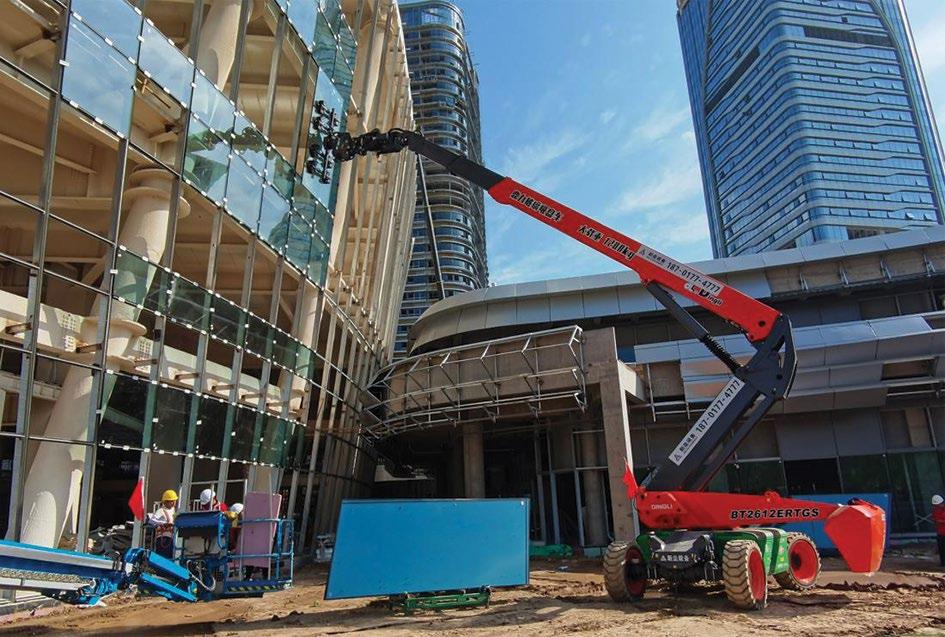
On most glazing robots, the glass manipulator itself is offset from the boom. The top of the pane will typically be above the head of the boom, allowing it to be positioned easily under obstructions. This all combines, in most instances, to deliver a machine that can be offered on bare rental or owned by the end user with only basic familiarisation needed for operation. In many cases they can be used with different vacuum cups to install other materials such as metal or stone façade panels. There are many manufacturers of glazing robots. Some of the more recent models include Germany’s Uplifter which launched the 1,125kg ‘Beast’ Glassworker GW 1125 a few years ago and UK based GGR’s largest glazing robot - the 1,400kg Oscar 1400 - aimed at lifting a range of materials from heavy glass, ceramic plates, plastic boards and other non-porous materials. Denmark’s GMV has been building specialist load handling devices for more than 30 years including Winlet glazing robots. One of its latest is the fully hydraulic Winlet 400. On earlier machines, the manipulator at the front of the robot had been able to move loads from side to side using a mechanical actuator. On the 400, this movement can now be powered by hydraulic cylinders, offering a more compact and powerful machine overall but at the cost of a little reach and height.
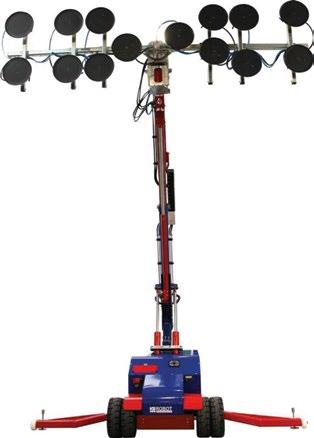


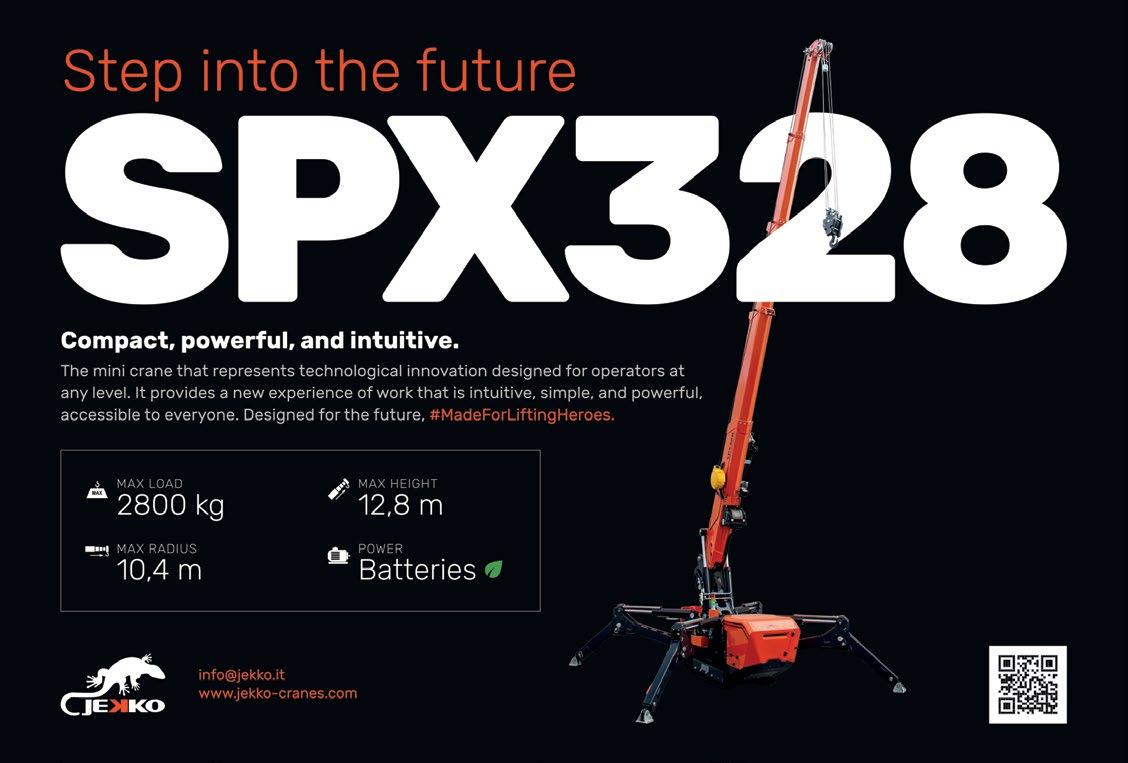
Applications
UK based crane and glass handling specialist GGR has worked in this sector for around 25 years and has always been on the lookout for new ideas and technology. It now runs an extensive range of glass handling machinesrobots, mini cranes and booms - and a variety of attachments to deal with the multitude of different project requirements. We take a look at two totally different applications - Rochdale Town Hall and the Arendal Spirit shipwhich show the range of equipment that is needed when installing panes of glass. Also, we see how Bavaria based Heavylift installs large and heavy panes of glass at an altitude of more than 2,000 metres in the Dolomite mountains of Italy.
Replacing glass at sea
Glass handling equipment is not just needed on construction sites. GGR has successfully completed an unusual project to replace seven new glass panels on the captain’s bridge of the Arendal Spirit ship - a 50,000 tonne platform with an overall length of 74 metres and beam of 75 metres - based in Tenerife. The task was even more challenging due to the immediate vicinity of the sensitive electronics used to control the ship. GGR used a Libro 1200 3D Head Overhang Beam to help install the glass panels which weighed between 330kg and 670kg each and required precise and careful handling to ensure safety and avoid damage to the nearby systems.
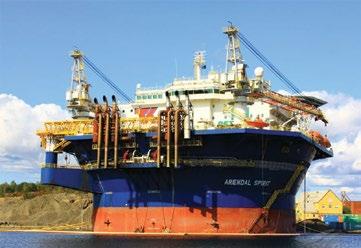
Load capacity and space
One of the major considerations was the ship floor load capacity of 500kg per square metre which required careful planning in terms of weight distribution during the installation. However, by attaching the Libro Overhang Beam to the ship’s onboard crane, it effectively eliminated the floor loading constraints.
With only a 1.27 metre distance between the glass installation point and the ship’s electronics, the installation required extremely accurate handling. The glass needed to fit into a 1.15 metre opening and then installed horizontally above the control systems. The team successfully replaced the more difficult to access panels thanks to the remote controller.
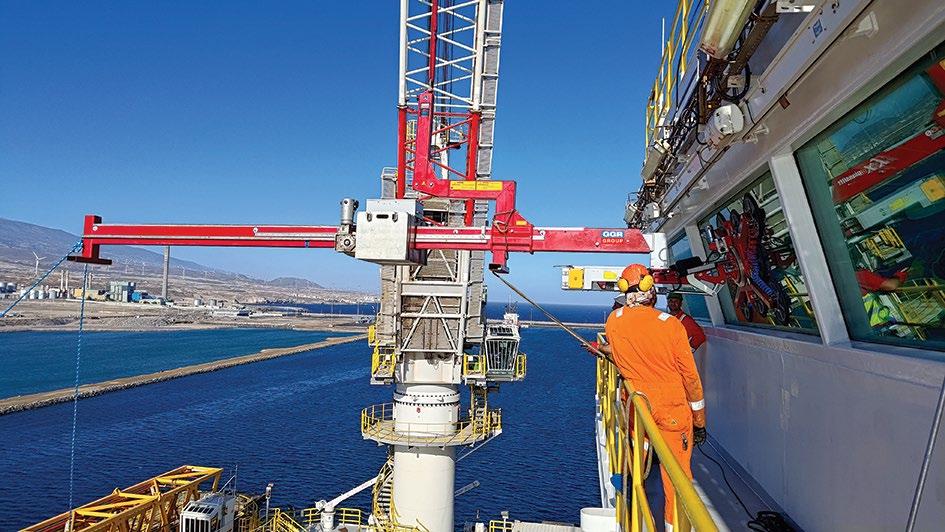
Libro 1200 3D head
The Libro 1200 3D Head Overhang Beam is designed for high and low level lifting tasks and is the ideal choice for installing large glass panels weighing up to 1,200kg for flat and 1,000kg for curved glass on vertical or inclined façade elements, in hard to reach places such as façade apertures, soffits and overhangs of up to three metres.
The counterweight saddle is moveable along the beam to balance the load and is operated by cable or radio remote control. The anti-tilt switch prevents the counterweight balancer from tilting more than 10 degrees, ensuring stability and safety.

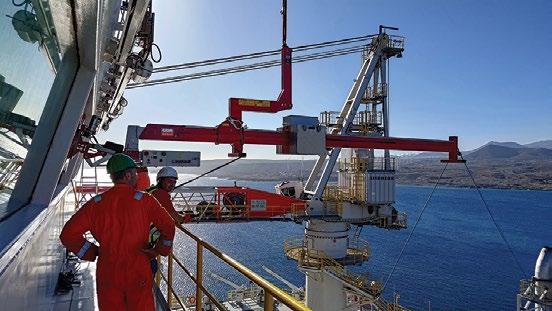


Rochdale town hall
The historic Rochdale Town Hall building in Greater Manchester required two different types of glass to be installed to archway reveals. The grade one listed building was designed by William Crossland and opened in 1871 to symbolise the town’s rich industrial standing in the textile trade. It is said that its ornate stylings are rivalled only by the Palace of Westminster.
The intricate project involved installing smaller arch tops over doorways and three large single unit pieces requiring precision and specialist lifting equipment to ensure the glass was securely and accurately placed within the archway structures and beneath the portico soffits.
Because of the size and weight of the glass - the largest panels were 5.6 metres long and weighed up to 1,000kg - the installation required a Unic URW-706 spider crane with Libro 2500B overhang beam and GL-UMC1200 glass manipulating head. The combination allowed the crew to guide the glass panes below the portico overhangs into the archway reveals with relative ease. The beam balances the load and is operated by either a cable or a radio remote control.
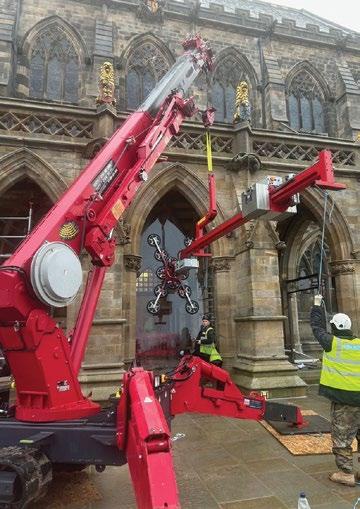
Manipulating head
The GL-UMC 1200 manipulating head enabled the rotation and manoeuvring of the glass pieces with great precision ensuring they could be accurately fitted into the designated areas. Depending on the configuration, the GL-UMC 1200 has the ability to lift both flat glass panels of 800kg or 1,200kg and curved glass up to 1,000kg with a minimum radius of two metres and manipulate it into position, with plus or minus 60 degree tilt, plus or minus 40 degree slew and 360 degree continuous rotation, all controlled via radio remote control.
Installation process
First the glass needed to be lifted from the stillage, rotated vertically and then manipulated with the GL-UMC 1200 into the portico. The smaller arch top panels were positioned over the doorways and manoeuvred into place. The large single units required more complex handling. Once in the portico, the glass needed to be pulled back into the rebate for the glass to be fitted securely.
The tight fit of the glass around the frame required using the counterbalance beam and GLUMC-1200 manipulating head. This allowed the URW-706

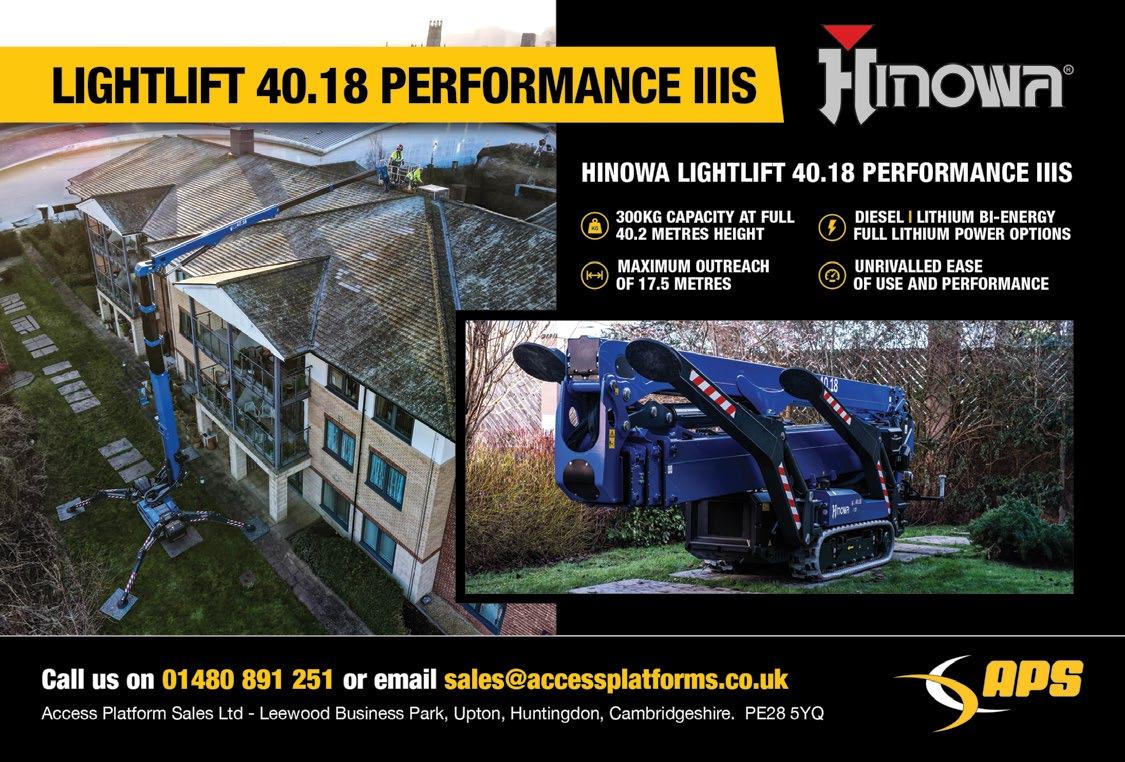
Glass mountain installation
The conversion of the former 2025 metre high Sesto/Sexten cable car mountain station on Monte Elmo in the Dolomites region in South Tyrol, Italy into the Messner Mountain Museum (MMM) Roca, created a few challenges for Bavarian glass installation company Heavydrive.
Design practice Plasma Studio and architect Ulla Hell undertook the conversion, trying to repurpose and preserve as much of the existing structure and industrial character as possible, while integrating new structural elements including a panoramic glazed façade which offers impressive view of the surrounding mountain landscape.
Work on the project began in October 2023 starting with transporting the necessary equipment by truck up the narrow mountain roads and gravel tracks to the site at an altitude
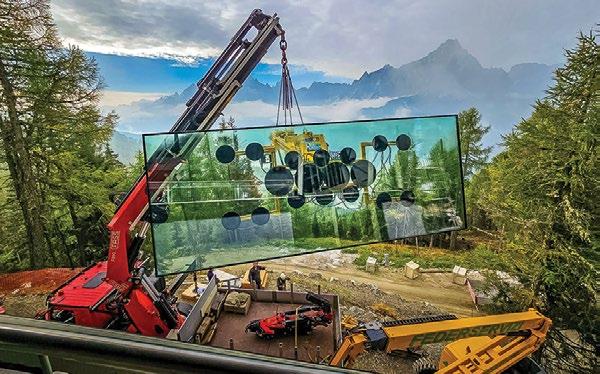
of 2,050 metres. The 6.0 by 2.3 metre panels weighing up to 1,700kg were supplied by façade construction company Frener & Reifer based in the South Tyrol and had to be set into a 17 degree sloping façade. A few were also installed horizontally overhead with the whole job completed within two days and in poor weather conditions. An experienced Heavydrive operator used a truck mounted Fassi F990 loader crane with a 2,000kg capacity VSG 2000 KMHL vacuum head with slope adapter together with a VSG 3000 counterweight beam for the installation.
Before the work began, the equipment’s air pressure had to be acclimatised to the 2,000 metres plus altitude. The façade elements were then able to be safely picked up, transported to the opening and swivelled to the required outside inclination of 17 degrees using the slope adapter. This made it possible to set the panes from the outside.
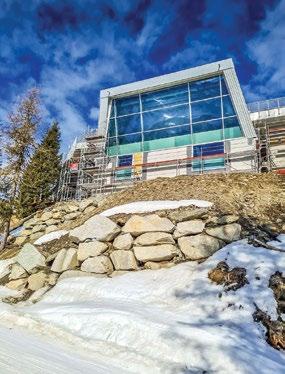
The VSG KMHL vacuum suction system also has infinitely adjustable cups. This allowed the operator to set the smaller, triangular edge panes of the façade using the same system but smaller cups which are easily swopped out.
“The assignment has shown us that having an experienced operator on site makes sense and ultimately saves costs, especially when it comes to challenging projects,” says Heavydrive managing director Günter Übelacker. “Drawing on his experience, the operator decided for time reasons to quickly modify the larger system to handle the smaller panes rather than using smaller equipment. As a result, the assignment was completed on time.”
There are six Messner Mountain Museum locations in South Tyrol. The last to open this autumn will be the Roca on Monte Elmo in Sesto, where the theme is dedicated to ‘rock’ and ‘rock climbing’.
